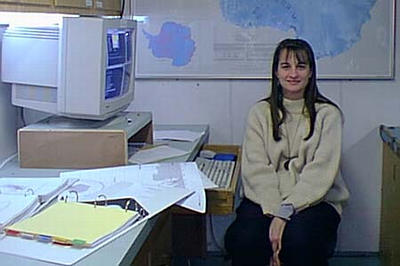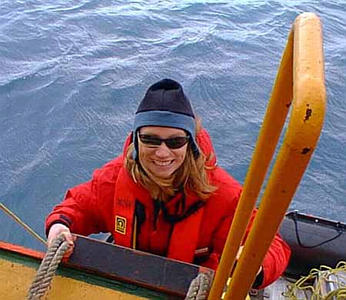
|
|
20 March, 1999
March 20, 1999
Hi from the Antarctic Peninsula! We had an awesome day today! To begin
with, it WASN'T foggy outside . . . and we could see the mountains and the
glaciers. Secondly, we went to Palmer Station. The ship had some cargo to
unload at Palmer Station, and there were five passengers that came aboard
our ship for the trip to Chile. We spent a total of about four hours
there, and we were even able to climb aboard zodiacs (inflatable rubber
rafts with outboard motors) and go ashore! While we were there, we walked
around and saw the buildings, visited with some of the people that are
going to remain at Palmer Station for the winter, and walked up to the
glacier that's about 0.5 miles from the station. Once we returned to the
ship, we were greeted with BBQ chicken (Ernest had the grill going while we
went ashore)! Yummm . . .
So, let's look at our question for today: "Why do you suppose that we can
stop at Palmer Station, but McMurdo Station (where we started out) is
already closed for the winter? The answer is in our latitude! Palmer
Station is the only U.S. Antarctic station north of the Antarctic Circle.
The temperature is much more mild at Palmer Station, with monthly
temperatures ranging from +18 degrees Fahrenheit in July and August to +36
degrees Fahrenheit in January. The average temperature at Palmer Station
is about 27 degrees Fahrenheit -- much different from an average of 0
degrees Fahrenheit at McMurdo Station and -56 degrees Fahrenheit at
Amundsen-Scott South Pole Station! It was warm enough that we even had a
few sprinkles of rain while we were walking around. Palmer Station has
recorded rain during every month of the year. The record for precipitation
at Palmer Station was 1981 . . . when they received 10 inches of rain and
over 100 inches of snowfall!
Palmer Station is situated on the southwestern coast of Anvers Island, off
the Antarctic Peninsula. It's built on solid rock, and consists of two
major buildings, three smaller buildings, two large fuel tanks, a
helicopter pad, and a dock. Although no planes are able to land at Palmer
Station, it is accessible to icebreakers (like the NBP) any month of the
year. Usually, ships arrive at Palmer by crossing the Drake Passage from
South America. All of Palmer Station's supplies are brought by ship --
mail, personnel, cargo, food, scientific equipment, etc. Large ships, like
the Nathaniel B. Palmer, are not able to pull right up to the dock at the
station. As a result, the ships remain out in the deeper water while the
people and the cargo ride zodiacs to get to shore.
Palmer Station is not as large as the other U.S. research stations in
Antarctica. During the summer, the population reaches about 43, but during
the winter it's down to about 20. Due to its location on the Antarctic
Peninsula, a lot of biological studies are conducted there. It is also
used for the studies of meteorology, upper atmosphere physics, glaciology,
and geology . . . and it's been designated as a Long-Term Ecological
Research (LTER) site by the National Science Foundation.
Palmer Station (like our ship, the Nathaniel B. Palmer) is named for
Nathaniel Brown Palmer. He was a sealer from Connecticut who left his home
at the age of 14 to go to sea. When Nathaniel Brown Palmer was 21 years
old, he was the captain of a 46 foot sloop called the Hero and was on his
second sealing voyage to the South Shetlands. On November 16 and 17, 1820,
the Hero entered Orleans Strait and came very close to land on the
Antarctic Peninsula. Palmer was one of the first people to actually see
the continent (although most sources agree that he probably saw it after
both Bellingshausen and Bransfield). In addition to both Palmer Station
and the NBP, Palmer Land is the name given to the southern portion of the
Antarctic Peninsula in his honor.
Today, I wanted to introduce the last of the people hired to work on the
ship. We have talked about the employees of Edison Chouest Offshore (ECO)
like Captain Joe and J.P.. We have looked at the employees of Antarctic
Support Associates (ASA) like Don Michaelson and Jesse Doren. The last
person to discuss is Suzanne O'Hara. She lives with Jay Ardai (one of the
MTs on this cruise) about 20 minutes north of New York City. She graduated
from Rensselaer Polytechnic Institute, which is an engineering university
in Troy, New York. She has a degree in Computer Science with a minor in
Earth Science. Suzanne works for Doherty Earth Observatory of Columbia
University developing, designing, and building software for scientists and
training people to use it.
Because Suzanne is so familiar with much of the software and hardware that
is used for the Multibeam, she is often contracted to come aboard the
Nathaniel B. Palmer and help the scientists. On the NBP, she is mostly
hired to work with groups that use the Multibeam a lot or groups that use a
lot of CTDs. She has experience on many different ships from many
different countries. She has spent a great deal of time on ships since
1985. From 1985 - 1992, she alternated working on ships and working in ice
camps with scientists in both the Arctic and the Antarctic. For ice camps,
they would set up camp (complete with computers and equipment) in tents
that were on top of large pieces of floating ice. They would collect their
data by drilling down through the ice -- but they weren't able to make
decisions about where the ice would go. They just had to float wherever the
ice went. Although ice camps were very interesting, Suzanne really feels
like she has a family aboard the Nathaniel B. Palmer. In the last year,
she has spent nearly 6 months aboard the NBP working for different groups.
Although working aboard the ship doesn't provide as much of an opportunity
to develop new software as she would sometimes like, she thinks that this
is a very nice ship -- with nice people and good food -- and she really
enjoys working here in Antarctica. Suzanne is especially pleased that she
and Jay are working on the Palmer together right now. This is the first
time in about two years that they have had the opportunity to sail together.
In Suzanne's introduction, we learned that she spent a great deal of time
in both the Arctic and the Antarctic. What are some differences between
these two locations? We'll look at that in tomorrow's journal. For
tonight and tomorrow, we are planning to conduct some multibeam surveys
along the west coast of the Antarctic Peninsula. Before too long, we will
be leaving Antarctica and heading north across the Drake Passage. I will
continue writing journals and sending back photos for as long as we have
email connections (hopefully through next Saturday). I will write one last
journal entry on Sunday (after I get home) to let you know about my return
trip to the United States. Sometime before this expedition is complete, I
would really appreciate it if all of you would sign the guestbook at my
school's website. If you have a class of students that are following along
on this journey, please include the grade level(s) of your classroom, the
name of your school, and your location (city, state). If you are reading
this journal from the TEA (Teachers Experiencing Antarctica and the Arctic)
website, click on the button "See Kim's journal with added links" in order
to get to my school's web page. The guestbook can be found at the top of
the calendar page. I hope you're enjoying this expedition as much as I am!
I just can't believe how fast the days are flying by . . .
Kim Giesting
Latitude: 64 degrees 53 minutes South
Longitude: 63 degrees 42 minutes West
Temperature: 2.5 degrees Celsius
Barometer: 994.0 millibars
Wind Speed: 14.2 knots
Wind Direction: 040 degrees (from the Northeast)
Sunrise: 07:18
Sunset: 19:35

Suzanne has been hired to provide multibeam support for our cruise. She is the person that processes all of the data and prints the maps that we have been making.

This is a view of Palmer Station as seen from the RV/IB Nathaniel B. Palmer.

Ashley was the first scientist to go over the rope ladder and get into a zodiac!
Contact the TEA in the field at
.
If you cannot connect through your browser, copy the
TEA's e-mail address in the "To:" line of
your favorite e-mail package.
|
